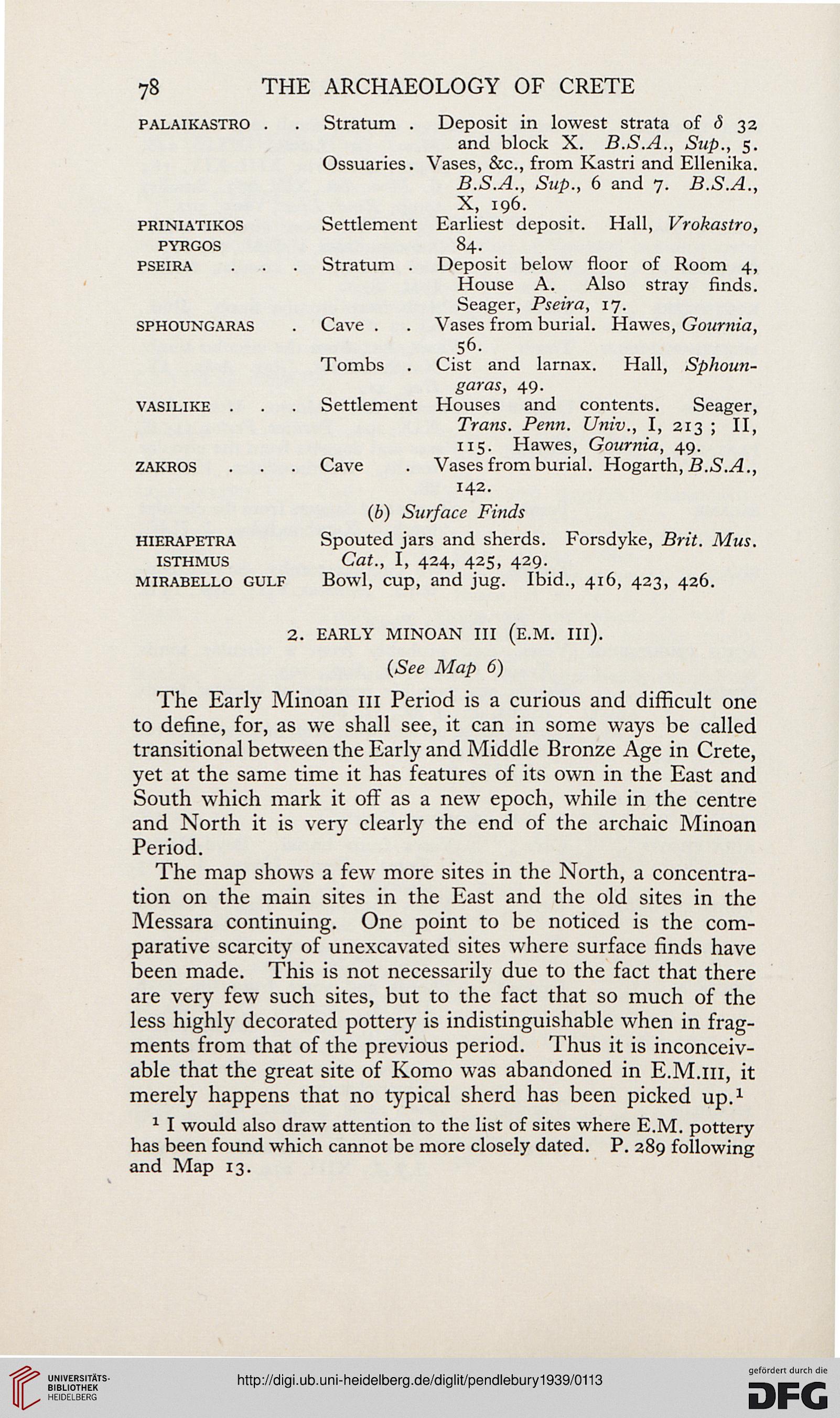78 THE ARCHAEOLOGY OF CRETE
PALAIKASTRO
PRINIATIKOS
PYRGOS
PSEIRA
SPHOUNGARAS
VASILIKE
ZAKROS
HIERAPETRA
ISTHMUS
MIRABELLO GULF
Deposit in lowest strata of <5 32
and block X. B.S.A., Sup., 5.
Vases, &c, from Kastri and Ellenika.
B.S.A., Sup., 6 and 7. B.S.A.,
X, 196.
Earliest deposit. Hall, Vrokastro,
84. .
Deposit below floor of Room 4,
House A. Also stray finds.
Seager, Pseira, 17.
Vases from burial. Hawes, Gournia,
56.
Cist and larnax. Hall, Sphoun-
garas, 49.
Houses and contents. Seager,
Trans. Penn. Univ., I, 213 ; II,
115. Hawes, Gournia, 49.
Vases from burial. Hogarth, B.S.A.,
142.
(6) Surface Finds
Spouted jars and sherds. Forsdyke, Brit. Mus.
Cat., I, 424, 425, 429.
Bowl, cup, and jug. Ibid., 416, 423, 426.
Stratum .
Ossuaries.
Settlement
Stratum .
Cave .
Tombs
Settlement
Cave
2. early minoan iii (e.m. iii).
(See Map 6)
The Early Minoan in Period is a curious and difficult one
to define, for, as we shall see, it can in some ways be called
transitional between the Early and Middle Bronze Age in Crete,
yet at the same time it has features of its own in the East and
South which mark it off as a new epoch, while in the centre
and North it is very clearly the end of the archaic Minoan
Period.
The map shows a few more sites in the North, a concentra-
tion on the main sites in the East and the old sites in the
Messara continuing. One point to be noticed is the com-
parative scarcity of unexcavated sites where surface finds have
been made. This is not necessarily due to the fact that there
are very few such sites, but to the fact that so much of the
less highly decorated pottery is indistinguishable when in frag-
ments from that of the previous period. Thus it is inconceiv-
able that the great site of Komo was abandoned in E.M.iii, it
merely happens that no typical sherd has been picked up.1
1 I would also draw attention to the list of sites where E.M. pottery
has been found which cannot be more closely dated. P. 289 following
and Map 13.
PALAIKASTRO
PRINIATIKOS
PYRGOS
PSEIRA
SPHOUNGARAS
VASILIKE
ZAKROS
HIERAPETRA
ISTHMUS
MIRABELLO GULF
Deposit in lowest strata of <5 32
and block X. B.S.A., Sup., 5.
Vases, &c, from Kastri and Ellenika.
B.S.A., Sup., 6 and 7. B.S.A.,
X, 196.
Earliest deposit. Hall, Vrokastro,
84. .
Deposit below floor of Room 4,
House A. Also stray finds.
Seager, Pseira, 17.
Vases from burial. Hawes, Gournia,
56.
Cist and larnax. Hall, Sphoun-
garas, 49.
Houses and contents. Seager,
Trans. Penn. Univ., I, 213 ; II,
115. Hawes, Gournia, 49.
Vases from burial. Hogarth, B.S.A.,
142.
(6) Surface Finds
Spouted jars and sherds. Forsdyke, Brit. Mus.
Cat., I, 424, 425, 429.
Bowl, cup, and jug. Ibid., 416, 423, 426.
Stratum .
Ossuaries.
Settlement
Stratum .
Cave .
Tombs
Settlement
Cave
2. early minoan iii (e.m. iii).
(See Map 6)
The Early Minoan in Period is a curious and difficult one
to define, for, as we shall see, it can in some ways be called
transitional between the Early and Middle Bronze Age in Crete,
yet at the same time it has features of its own in the East and
South which mark it off as a new epoch, while in the centre
and North it is very clearly the end of the archaic Minoan
Period.
The map shows a few more sites in the North, a concentra-
tion on the main sites in the East and the old sites in the
Messara continuing. One point to be noticed is the com-
parative scarcity of unexcavated sites where surface finds have
been made. This is not necessarily due to the fact that there
are very few such sites, but to the fact that so much of the
less highly decorated pottery is indistinguishable when in frag-
ments from that of the previous period. Thus it is inconceiv-
able that the great site of Komo was abandoned in E.M.iii, it
merely happens that no typical sherd has been picked up.1
1 I would also draw attention to the list of sites where E.M. pottery
has been found which cannot be more closely dated. P. 289 following
and Map 13.




